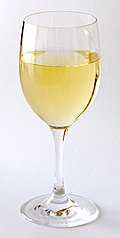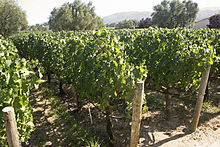Main article: History of wine
Archaeological evidence suggests that the earliest known production of wine, made by fermenting grapes, took place as early as 8,000 years ago in Georgia[5] and 6,100 years ago in Armenia.[15][16][6] These locations are all within the natural area of the European grapevine Vitis vinifera.Through an extensive gene-mapping project in 2006, Dr. McGovern and his colleagues analyzed the heritage of more than 110 modern grape cultivars, and narrowed their origin to a region in Georgia, where also wine residues were discovered on the inner surfaces of 8,000-year-old ceramic storage jars in Shulavari, Georgia.[17]Other notable areas of wine production have been discovered in Greece and date back to 4500 BC.[18][19][20][16] The same sites also contain the world's earliest evidence of crushed grapes.[18] On January 11, 2011 in one of Armenia's Vayots Dzor province cave was found a wine making press dating to approximately 6,000 years ago.[20][16][21] Literary references to wine are abundant in Homer (9th century BC, but possibly composed even earlier), Alkman (7th century BC), and others. In Ancient Egypt, six of 36 wine amphoras were found in the tomb of King Tutankhamun bearing the name "Kha'y", a royal chief vintner. Five of these amphoras were designated as from the King's personal estate with the sixth listed as from the estate of the royal house of Aten.[22] Traces of wine have also been found in central Asian Xinjiang, dating from the second and first millennia BC.[23]
Viticulture in India has a long history dating back to the time of the Indus Valley civilization when grapevines were believed to have been introduced from Persia sometime in the 5000 BC.[citation needed] The first known mentioning of grape-based wines was in the late 4th century BC writings of Chanakya who was the chief minister of Emperor Chandragupta Maurya. In his writings, Chanakya condemns the use of alcohol while chronicling the emperor and his court's frequent indulgence of a style of grape wine known as Madhu.[24]
A 2003 report by archaeologists indicates a possibility that grapes were mixed with rice to produce mixed fermented beverages in China in the early years of the seventh millennium BC. Pottery jars from the Neolithic site of Jiahu, Henan contained traces of tartaric acid and other organic compounds commonly found in wine. However, other fruits indigenous to the region, such as hawthorn, cannot be ruled out.[25][26] If these beverages, which seem to be the precursors of rice wine, included grapes rather than other fruits, these grapes were of any of the several dozen indigenous wild species of grape in China, rather than from Vitis vinifera, which were introduced into China some 6000 years later.[25]
One of the lasting legacies of the ancient Roman Empire was the viticulture foundation the Romans laid in the lands that today are world renowned wine regions. Areas with Roman garrison towns, like Bordeaux, Trier, and Colchester, the Romans planted vineyards to supply local needs and limit the cost of long distance trading.[27] In medieval Europe, the Roman Catholic Church staunchly supported wine, since they required it for the Mass. Monks in France made wine for years, aging it in caves.[28] An old English recipe that survived in various forms until the 19th century calls for refining white wine from bastard—bad or tainted bastardo wine.[29]





